Sofien Bouaziz
GenCA: A Text-conditioned Generative Model for Realistic and Drivable Codec Avatars
Aug 24, 2024


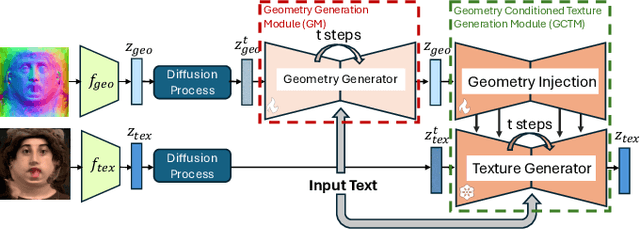
Abstract:Photo-realistic and controllable 3D avatars are crucial for various applications such as virtual and mixed reality (VR/MR), telepresence, gaming, and film production. Traditional methods for avatar creation often involve time-consuming scanning and reconstruction processes for each avatar, which limits their scalability. Furthermore, these methods do not offer the flexibility to sample new identities or modify existing ones. On the other hand, by learning a strong prior from data, generative models provide a promising alternative to traditional reconstruction methods, easing the time constraints for both data capture and processing. Additionally, generative methods enable downstream applications beyond reconstruction, such as editing and stylization. Nonetheless, the research on generative 3D avatars is still in its infancy, and therefore current methods still have limitations such as creating static avatars, lacking photo-realism, having incomplete facial details, or having limited drivability. To address this, we propose a text-conditioned generative model that can generate photo-realistic facial avatars of diverse identities, with more complete details like hair, eyes and mouth interior, and which can be driven through a powerful non-parametric latent expression space. Specifically, we integrate the generative and editing capabilities of latent diffusion models with a strong prior model for avatar expression driving. Our model can generate and control high-fidelity avatars, even those out-of-distribution. We also highlight its potential for downstream applications, including avatar editing and single-shot avatar reconstruction.
SSDNeRF: Semantic Soft Decomposition of Neural Radiance Fields
Dec 07, 2022



Abstract:Neural Radiance Fields (NeRFs) encode the radiance in a scene parameterized by the scene's plenoptic function. This is achieved by using an MLP together with a mapping to a higher-dimensional space, and has been proven to capture scenes with a great level of detail. Naturally, the same parameterization can be used to encode additional properties of the scene, beyond just its radiance. A particularly interesting property in this regard is the semantic decomposition of the scene. We introduce a novel technique for semantic soft decomposition of neural radiance fields (named SSDNeRF) which jointly encodes semantic signals in combination with radiance signals of a scene. Our approach provides a soft decomposition of the scene into semantic parts, enabling us to correctly encode multiple semantic classes blending along the same direction -- an impossible feat for existing methods. Not only does this lead to a detailed, 3D semantic representation of the scene, but we also show that the regularizing effects of the MLP used for encoding help to improve the semantic representation. We show state-of-the-art segmentation and reconstruction results on a dataset of common objects and demonstrate how the proposed approach can be applied for high quality temporally consistent video editing and re-compositing on a dataset of casually captured selfie videos.
Multiresolution Deep Implicit Functions for 3D Shape Representation
Sep 16, 2021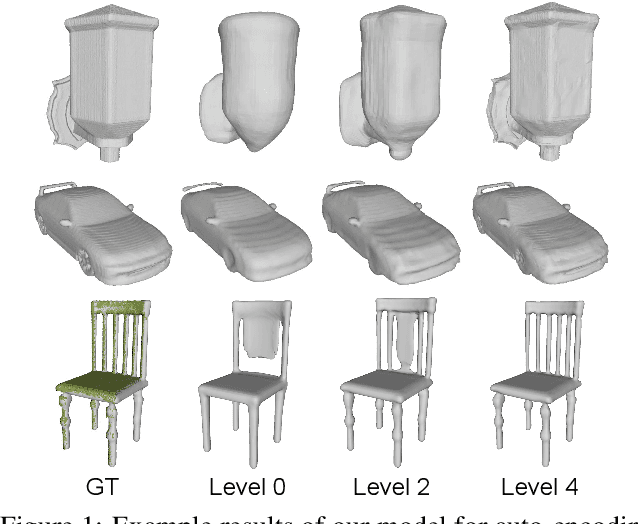
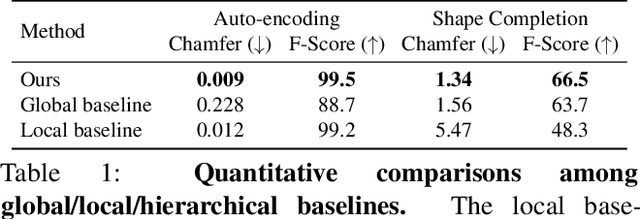
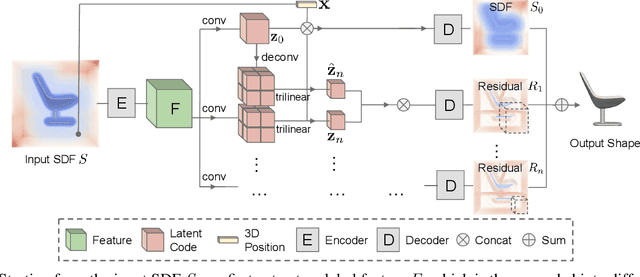
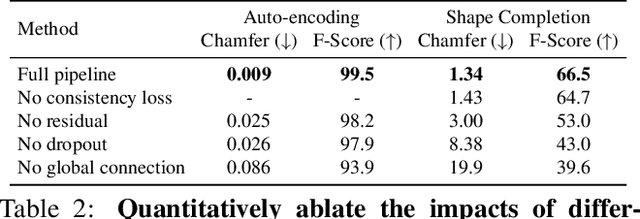
Abstract:We introduce Multiresolution Deep Implicit Functions (MDIF), a hierarchical representation that can recover fine geometry detail, while being able to perform global operations such as shape completion. Our model represents a complex 3D shape with a hierarchy of latent grids, which can be decoded into different levels of detail and also achieve better accuracy. For shape completion, we propose latent grid dropout to simulate partial data in the latent space and therefore defer the completing functionality to the decoder side. This along with our multires design significantly improves the shape completion quality under decoder-only latent optimization. To the best of our knowledge, MDIF is the first deep implicit function model that can at the same time (1) represent different levels of detail and allow progressive decoding; (2) support both encoder-decoder inference and decoder-only latent optimization, and fulfill multiple applications; (3) perform detailed decoder-only shape completion. Experiments demonstrate its superior performance against prior art in various 3D reconstruction tasks.
HyperNeRF: A Higher-Dimensional Representation for Topologically Varying Neural Radiance Fields
Jun 24, 2021
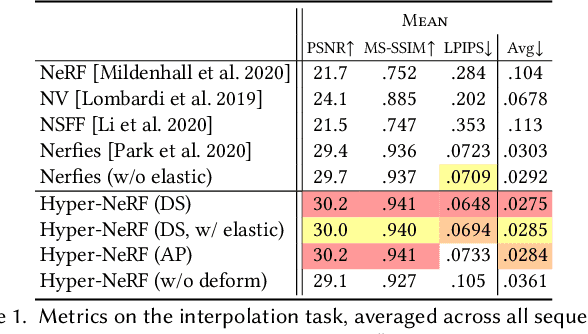
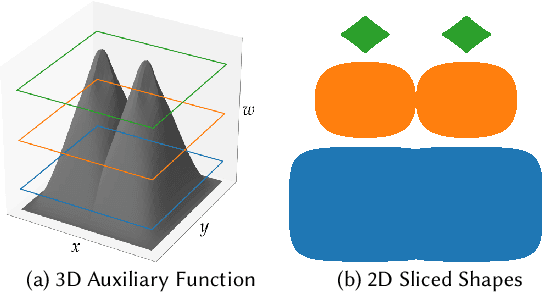

Abstract:Neural Radiance Fields (NeRF) are able to reconstruct scenes with unprecedented fidelity, and various recent works have extended NeRF to handle dynamic scenes. A common approach to reconstruct such non-rigid scenes is through the use of a learned deformation field mapping from coordinates in each input image into a canonical template coordinate space. However, these deformation-based approaches struggle to model changes in topology, as topological changes require a discontinuity in the deformation field, but these deformation fields are necessarily continuous. We address this limitation by lifting NeRFs into a higher dimensional space, and by representing the 5D radiance field corresponding to each individual input image as a slice through this "hyper-space". Our method is inspired by level set methods, which model the evolution of surfaces as slices through a higher dimensional surface. We evaluate our method on two tasks: (i) interpolating smoothly between "moments", i.e., configurations of the scene, seen in the input images while maintaining visual plausibility, and (ii) novel-view synthesis at fixed moments. We show that our method, which we dub HyperNeRF, outperforms existing methods on both tasks by significant margins. Compared to Nerfies, HyperNeRF reduces average error rates by 8.6% for interpolation and 8.8% for novel-view synthesis, as measured by LPIPS.
HumanGPS: Geodesic PreServing Feature for Dense Human Correspondences
Mar 29, 2021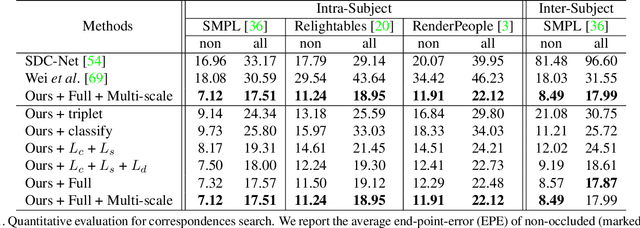


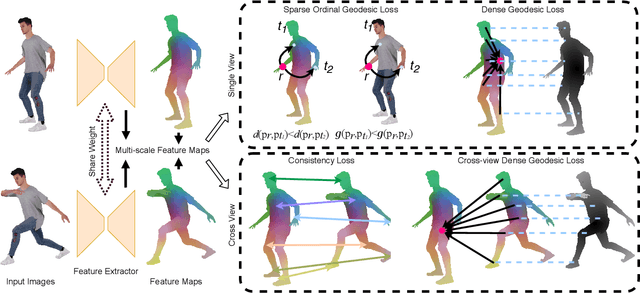
Abstract:In this paper, we address the problem of building dense correspondences between human images under arbitrary camera viewpoints and body poses. Prior art either assumes small motion between frames or relies on local descriptors, which cannot handle large motion or visually ambiguous body parts, e.g., left vs. right hand. In contrast, we propose a deep learning framework that maps each pixel to a feature space, where the feature distances reflect the geodesic distances among pixels as if they were projected onto the surface of a 3D human scan. To this end, we introduce novel loss functions to push features apart according to their geodesic distances on the surface. Without any semantic annotation, the proposed embeddings automatically learn to differentiate visually similar parts and align different subjects into an unified feature space. Extensive experiments show that the learned embeddings can produce accurate correspondences between images with remarkable generalization capabilities on both intra and inter subjects.
Improved Detection of Face Presentation Attacks Using Image Decomposition
Mar 22, 2021



Abstract:Presentation attack detection (PAD) is a critical component in secure face authentication. We present a PAD algorithm to distinguish face spoofs generated by a photograph of a subject from live images. Our method uses an image decomposition network to extract albedo and normal. The domain gap between the real and spoof face images leads to easily identifiable differences, especially between the recovered albedo maps. We enhance this domain gap by retraining existing methods using supervised contrastive loss. We present empirical and theoretical analysis that demonstrates that the contrast and lighting effects can play a significant role in PAD; these show up particularly in the recovered albedo. Finally, we demonstrate that by combining all of these methods we achieve state-of-the-art results on datasets such as CelebA-Spoof, OULU and CASIA-SURF.
Deformable Neural Radiance Fields
Nov 26, 2020


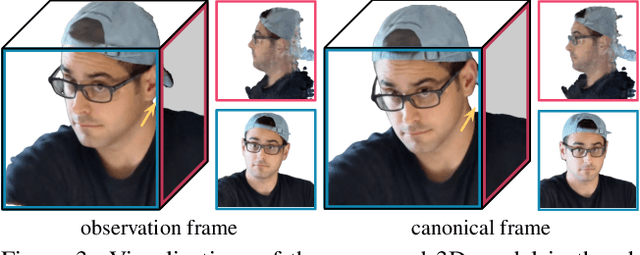
Abstract:We present the first method capable of photorealistically reconstructing a non-rigidly deforming scene using photos/videos captured casually from mobile phones. Our approach -- D-NeRF -- augments neural radiance fields (NeRF) by optimizing an additional continuous volumetric deformation field that warps each observed point into a canonical 5D NeRF. We observe that these NeRF-like deformation fields are prone to local minima, and propose a coarse-to-fine optimization method for coordinate-based models that allows for more robust optimization. By adapting principles from geometry processing and physical simulation to NeRF-like models, we propose an elastic regularization of the deformation field that further improves robustness. We show that D-NeRF can turn casually captured selfie photos/videos into deformable NeRF models that allow for photorealistic renderings of the subject from arbitrary viewpoints, which we dub "nerfies." We evaluate our method by collecting data using a rig with two mobile phones that take time-synchronized photos, yielding train/validation images of the same pose at different viewpoints. We show that our method faithfully reconstructs non-rigidly deforming scenes and reproduces unseen views with high fidelity.
GeLaTO: Generative Latent Textured Objects
Aug 11, 2020



Abstract:Accurate modeling of 3D objects exhibiting transparency, reflections and thin structures is an extremely challenging problem. Inspired by billboards and geometric proxies used in computer graphics, this paper proposes Generative Latent Textured Objects (GeLaTO), a compact representation that combines a set of coarse shape proxies defining low frequency geometry with learned neural textures, to encode both medium and fine scale geometry as well as view-dependent appearance. To generate the proxies' textures, we learn a joint latent space allowing category-level appearance and geometry interpolation. The proxies are independently rasterized with their corresponding neural texture and composited using a U-Net, which generates an output photorealistic image including an alpha map. We demonstrate the effectiveness of our approach by reconstructing complex objects from a sparse set of views. We show results on a dataset of real images of eyeglasses frames, which are particularly challenging to reconstruct using classical methods. We also demonstrate that these coarse proxies can be handcrafted when the underlying object geometry is easy to model, like eyeglasses, or generated using a neural network for more complex categories, such as cars.
* ECCV 2020 Spotlight. Project website: https://gelato-paper.github.io
HITNet: Hierarchical Iterative Tile Refinement Network for Real-time Stereo Matching
Jul 23, 2020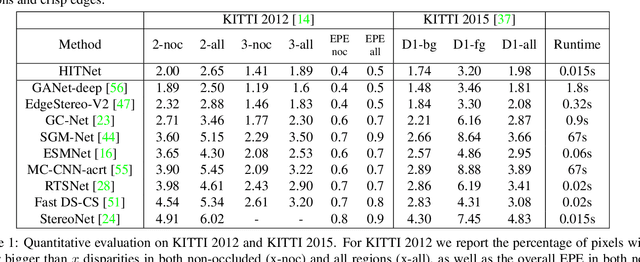
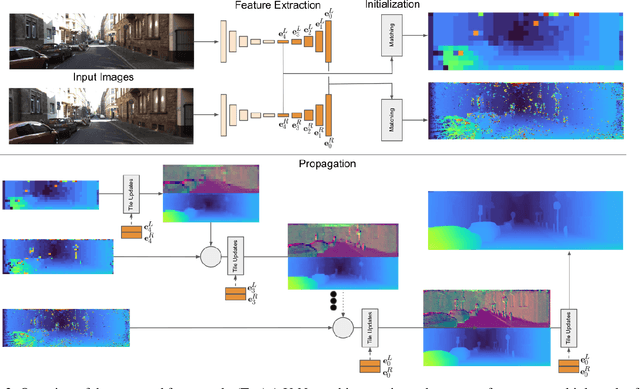

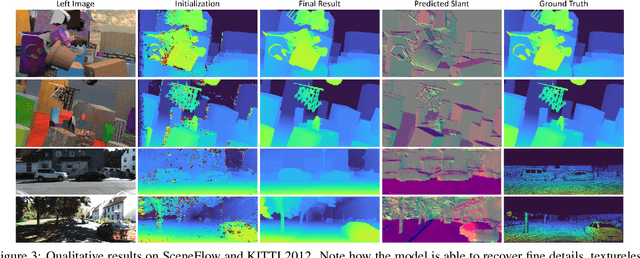
Abstract:This paper presents HITNet, a novel neural network architecture for real-time stereo matching. Contrary to many recent neural network approaches that operate on a full cost volume and rely on 3D convolutions, our approach does not explicitly build a volume and instead relies on a fast multi-resolution initialization step, differentiable 2D geometric propagation and warping mechanisms to infer disparity hypotheses. To achieve a high level of accuracy, our network not only geometrically reasons about disparities but also infers slanted plane hypotheses allowing to more accurately perform geometric warping and upsampling operations. Our architecture is inherently multi-resolution allowing the propagation of information at different levels. Multiple experiments prove the effectiveness of the proposed approach at a fraction of the computation required by recent state-of-the-art methods. At time of writing, HITNet ranks 1st-3rd on all the metrics published on the ETH3D website for two view stereo and ranks 1st on the popular KITTI 2012 and 2015 benchmarks among the published methods faster than 100ms.
Deep Implicit Volume Compression
May 18, 2020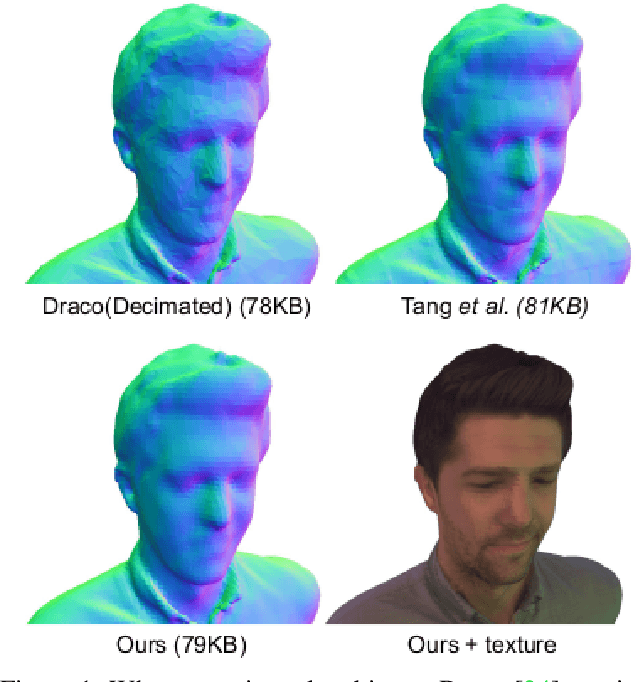



Abstract:We describe a novel approach for compressing truncated signed distance fields (TSDF) stored in 3D voxel grids, and their corresponding textures. To compress the TSDF, our method relies on a block-based neural network architecture trained end-to-end, achieving state-of-the-art rate-distortion trade-off. To prevent topological errors, we losslessly compress the signs of the TSDF, which also upper bounds the reconstruction error by the voxel size. To compress the corresponding texture, we designed a fast block-based UV parameterization, generating coherent texture maps that can be effectively compressed using existing video compression algorithms. We demonstrate the performance of our algorithms on two 4D performance capture datasets, reducing bitrate by 66% for the same distortion, or alternatively reducing the distortion by 50% for the same bitrate, compared to the state-of-the-art.
 Add to Chrome
Add to Chrome Add to Firefox
Add to Firefox Add to Edge
Add to Edge